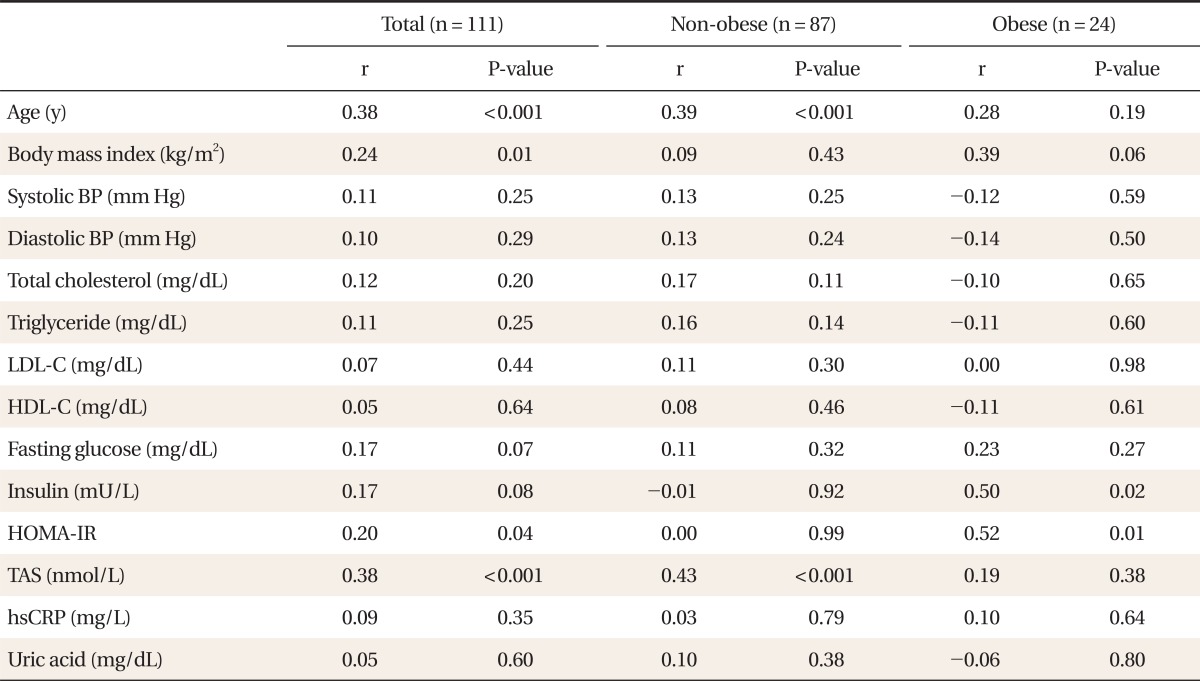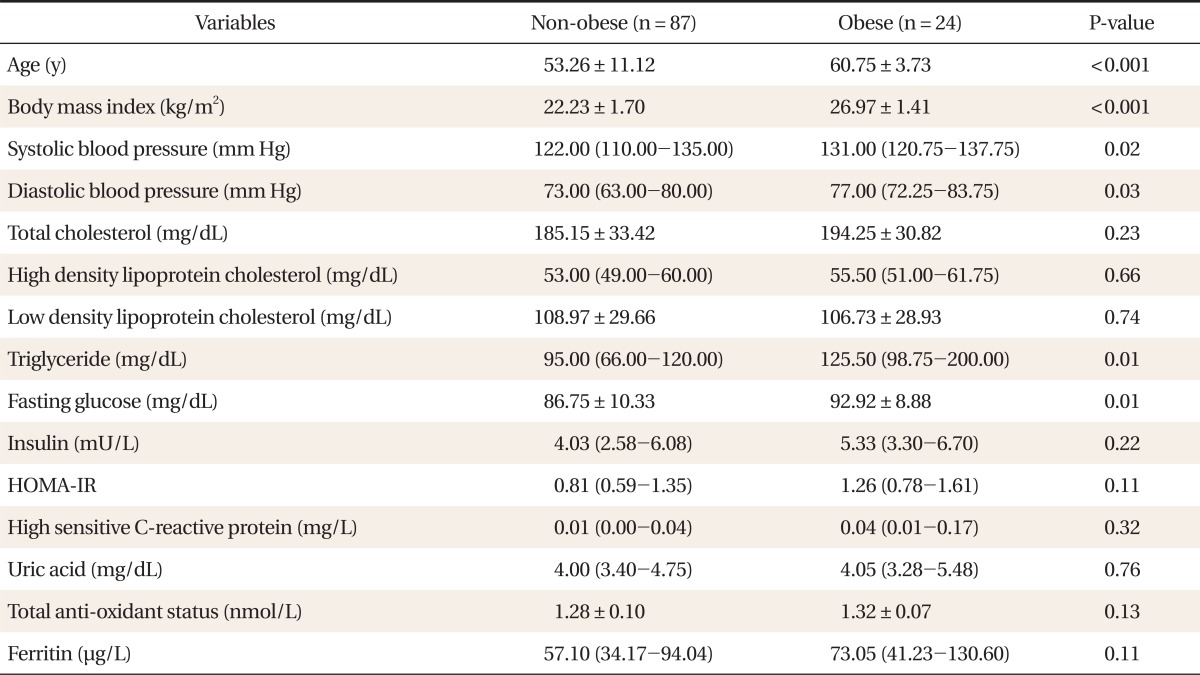1. Cook JD, Flowers CH, Skikne BS. The quantitative assessment of body iron. Blood 2003;101:3359-3364. PMID:
12521995.


2. Yoon JH, An SH, Kyeong IG, Lee MS, Kwon SC, Kang JH. Oxidative modification of ferritin induced by hydrogen peroxide. BMB Rep 2011;44:165-169. PMID:
21429293.


3. Galkina E, Ley K. Immune and inflammatory mechanisms of atherosclerosis (*). Annu Rev Immunol 2009;27:165-197. PMID:
19302038.



4. Galaris D, Pantopoulos K. Oxidative stress and iron homeostasis: mechanistic and health aspects. Crit Rev Clin Lab Sci 2008;45:1-23. PMID:
18293179.


5. You SA, Wang Q. Ferritin in atherosclerosis. Clin Chim Acta 2005;357:1-16. PMID:
15963791.


6. Sun L, Franco OH, Hu FB, Cai L, Yu Z, Li H, et al. Ferritin concentrations, metabolic syndrome, and type 2 diabetes in middle-aged and elderly chinese. J Clin Endocrinol Metab 2008;93:4690-4696. PMID:
18796516.


7. Jehn M, Clark JM, Guallar E. Serum ferritin and risk of the metabolic syndrome in U.S. adults. Diabetes Care 2004;27:2422-2428. PMID:
15451911.


8. Schulpis KH, Papastamataki M, Stamou H, Papassotiriou I, Margeli A. The effect of diet on total antioxidant status, ceruloplasmin, transferrin and ferritin serum levels in phenylketonuric children. Acta Paediatr 2010;99:1565-1570. PMID:
20491710.


9. Lin F, Girotti AW. Hemin-enhanced resistance of human leukemia cells to oxidative killing: antisense determination of ferritin involvement. Arch Biochem Biophys 1998;352:51-58. PMID:
9521813.


10. Lawson DM, Artymiuk PJ, Yewdall SJ, Smith JM, Livingstone JC, Treffry A, et al. Solving the structure of human H ferritin by genetically engineering intermolecular crystal contacts. Nature 1991;349:541-544. PMID:
1992356.


11. Western Pacific Regional Office of the World Health Organization. The International Association for the Study of Obesity. The International Obesity Task Force. The Asia-Pacific perspective: redefining obesity and its treatment. 2000. Sydney: Health Communications Australia.
12. Wolff SP. Diabetes mellitus and free radicals: free radicals, transition metals and oxidative stress in the aetiology of diabetes mellitus and complications. Br Med Bull 1993;49:642-652. PMID:
8221029.


13. Eshed I, Elis A, Lishner M. Plasma ferritin and type 2 diabetes mellitus: a critical review. Endocr Res 2001;27:91-97. PMID:
11428724.


14. Fernandez-Real JM, Lopez-Bermejo A, Ricart W. Cross-talk between iron metabolism and diabetes. Diabetes 2002;51:2348-2354. PMID:
12145144.


15. Balla G, Jacob HS, Balla J, Rosenberg M, Nath K, Apple F, et al. Ferritin: a cytoprotective antioxidant strategem of endothelium. J Biol Chem 1992;267:18148-18153. PMID:
1517245.


16. Lee M, Arosio P, Cozzi A, Chasteen ND. Identification of the EPR-active iron-nitrosyl complexes in mammalian ferritins. Biochemistry 1994;33:3679-3687. PMID:
8142366.


17. Cozzi A, Santambrogio P, Levi S, Arosio P. Iron detoxifying activity of ferritin: effects of H and L human apoferritins on lipid peroxidation in vitro. FEBS Lett 1990;277:119-122. PMID:
2269341.


18. Re R, Pellegrini N, Proteggente A, Pannala A, Yang M, Rice-Evans C. Antioxidant activity applying an improved ABTS radical cation decolorization assay. Free Radic Biol Med 1999;26:1231-1237. PMID:
10381194.


19. Sheu WH, Chen YT, Lee WJ, Wang CW, Lin LY. A relationship between serum ferritin and the insulin resistance syndrome is present in non-diabetic women but not in non-diabetic men. Clin Endocrinol (Oxf) 2003;58:380-385. PMID:
12608945.


20. Lantos J, Roth E, Czopf L, Nemes J, Gal I. Monitoring of plasma total antioxidant status in different diseases. Acta Chir Hung 1997;36:188-189. PMID:
9408341.

21. Zawadzka-Bartczak E. Activities of red blood cell anti-oxidative enzymes (SOD, GPx) and total anti-oxidative capacity of serum (TAS) in men with coronary atherosclerosis and in healthy pilots. Med Sci Monit 2005;11:CR440-CR444. PMID:
16127364.

22. Kuklinska AM, Mroczko B, Musial WJ, Sawicki R, Kozieradzka A, Waszkiewicz E, et al. High-sensitivity C-reactive protein and total antioxidant status in patients with essential arterial hypertension and dyslipidemia. Adv Med Sci 2009;54:225-232. PMID:
20053618.


23. Subash P, Premagurumurthy K, Sarasabharathi A, Cherian KM. Total antioxidant status and oxidative DNA damage in a South Indian population of essential hypertensives. J Hum Hypertens 2010;24:475-482. PMID:
20054348.


24. Pandzic Jaksic V. Adipocytokines as mediators of metabolic role of adipose tissue. Acta Med Croatica 2010;64:253-262. PMID:
21688608.

25. Wajchenberg BL. Subcutaneous and visceral adipose tissue: their relation to the metabolic syndrome. Endocr Rev 2000;21:697-738. PMID:
11133069.


26. Ikegami Y, Inukai K, Imai K, Sakamoto Y, Katagiri H, Kurihara S, et al. Adiponectin upregulates ferritin heavy chain in skeletal muscle cells. Diabetes 2009;58:61-70. PMID:
18931039.



27. Im JA, Kim SH, Lee JW, Shim JY, Lee HR, Lee DC. Association between hypoadiponectinemia and cardiovascular risk factors in nonobese healthy adults. Metabolism 2006;55:1546-1550. PMID:
17046559.


28. Matsuzawa Y, Funahashi T, Kihara S, Shimomura I. Adiponectin and metabolic syndrome. Arterioscler Thromb Vasc Biol 2004;24:29-33. PMID:
14551151.


29. Halle M, Korsten-Reck U, Wolfarth B, Berg A. Low-grade systemic inflammation in overweight children: impact of physical fitness. Exerc Immunol Rev 2004;10:66-74. PMID:
15633587.












